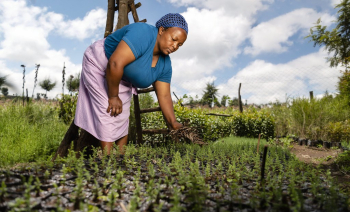The EU Gender Action Plan III (GAP III) builds on the EU's previous commitments to advancing women’s rights by promoting gender equality and the empowerment of women. GAP III recognises that to achieve gender equality we must further invest in understanding and addressing deep-rooted inequalities and contribute to countering gender stereotypes and biases. This is why GAP III establishes three principles that guide the EU’s approach to gender in external action: a gender-transformative approach, an approach that addresses intersectionality1 and an approach based on human rights.
Defining a Gender-Transformative Approach (GTA)
Adopting a GTA does not mean taking a completely new approach. A GTA is a framework designed to target the underlying causes of gender inequality. This requires a keen understanding of the power dynamics and structures that reinforce gender exclusion and inequality in the specific contexts and sectors in which we work. It incorporates actions that aim to transform those dynamics and structures, thus promoting change in social attitudes.2
Adopting a GTA is a process. All EU external actions should be guided by a gender-transformative approach and use a GTA lens in determining priorities and actions in policy dialogue and all sector interventions.
Against this background, the INTPA.G13 unit – with support from the INTPA.D44 unit -managed Methodological Knowledge Sharing (MKS) Programme – has published the infographic “Thinking out of the box to be gender transformative in our work”.5 Drawing on the infographic, we provide a list of practical tips on how to incorporate a GTA into your interventions.
The tips are presented as per intervention cycle phase.
Design phase
- Rely on the gender analysis (including a human rights and intersectionality approach, as well as analysis of unequal power dynamics). Do not forget to check the available GAP III Brief on Gender country profile and gender sector analysis.6
- Conduct inclusive, gender-responsive and participatory consultations by ensuring that women’s rights organisations are fully involved, engaging alongside men for gender equality organisations, youth activists, cooperatives, social enterprises or religious actors, among others.7
- Assess the GTA willingness and capacity of the implementing partner/s, and, if necessary, plan for training or technical assistance during the implementation of the intervention.
- Focus on long-term changes or gender-transformative outcomes in addition to outputs.
- Explore multiple ways to reinforce a GTA in order to reach the desired outcomes:
- A gender targeted intervention (Gender Marker 28) can have gender-transformative change as its main goal - for example, to transform gender relations to promote equity as a means to reach healthcare-related outcomes.
- GTA can be incorporated as part of specific interventions under the programme - for example, to engage men and boys in a programme to end gender-based violence.
- It can be an approach embedded in how activities are delivered - for example, by involving women in the design of a workshop, engaging families and communities in women’s economic activities or consulting traditional and community leaders in the planning phases.9
- Identify strategies to enable the rights of women in all their diversity and to promote not only their participation but also their meaningful engagement.10
- Include practical ways of recognising, reducing and redistributing unpaid care and household responsibilities more equally.
- Define gender indicators that capture changes in gender norms, attitudes and behaviours.
- Allocate appropriate budgets and technical expertise to promote this transformative change within the intervention.11
- Define specific risks linked to empowerment and transformative changes and their related mitigation measures.
- Be aware that any change occurring at an individual level is unsustainable without positive change at other levels such as in communities/institutions as well as to legal and policy frameworks. For example, the pathway a girl who joins a girls’ club may take depends partly on whether her family, wider community and institutions support her or not.
- And remember: when the intervention tackles several areas of change and takes both a multi-stakeholder and inclusive approach at the same time, gender-transformative change will come about more quickly and will be more sustainable.12
Implementation phase

- Continue to ask how the intervention can improve the full enjoyment of the rights of people of all genders.
- Ensure gender expertise and meaningful consultation and accountability during the full implementation for women rights organisations and other "gender actors".
- Monitor the participation and impact on rights holders regularly. For example, the burden of unpaid care, relational changes at home, active involvement in decision-making, etc.
- Track and record negative impacts and reactions, resistance, and unexpected outcomes and adopt measures to mitigate them. For instance, the possibility of increasing gender-based violence if men and boys are not properly involved in an intervention aimed at women’s empowerment, or the shift of care responsibilities to the younger (or older) women when an intervention provides training for women without providing care services or promoting a redistribution of unpaid care and household responsibilities.
- Set up a range of accessible feedback and complaint mechanisms for any unintended negative consequences (i.e. increase in domestic and gender-based violence).
Closure phase
- Go beyond measuring the participation of women and girls in activities as a means of gauging programme success. Participation is important but indicators must also be able to measure to what extent the programme implementation contributes to the transformation of gendered power relations.
- Rely on qualitative indicators and use gender-transformative methodologies that note how and by whom the learning process and post-evaluation was conducted.13
- Generate knowledge that is relevant for advancing gender transformation in the particular country/sectoral context.
Learn more by reading “Thinking out of the box to be gender transformative in our work”
Like, comment and share this article with your peers
1 Intersectionality is the framework that is used to study, understand and respond to the ways in which sex and gender intersect with other personal characteristics/identities, recognizing that these intersections contribute to unique experiences of power and privilege or discrimination and exclusion.
2 To achieve this, we must expand our engagement in gender beyond interventions that focus primarily on the needs of individual women – for example, increasing access to education, improving health services, providing technical skills or encouraging women to bolster their power and agency – and invest in actions that address deep-seated social norms and systems that reinforce gender inequalities.
3 Gender Equality, Human Rights and Democratic Governance (INTPA.G.1).
4 “Performance, results and evaluation; Internal communication, knowledge management and collaborative methods” (INTPA.D4).
5 The publication aims to provide recommendations on how to effectively support EU staff at Headquarters (HQ) and delegations (EUD) with orientation and tools regarding what transformative approaches are and how this principle is applied in practice to advance women’s rights.
6 For instance, in the case of Lebanon, the 2021 gender analysis has a specific section on patriarchal social and cultural norms.
7 If you would like to know more, you can consult the study “Working better together with CSOs to address gender inequality and champion women's and girls’ voice and agency” (pages 23-27).
8 For more information, you can check the Handbook on the OECD-DAC Gender Equality Policy Marker.
9 In the EU Compilation Transformative Promising Practices in Mainstreaming Gender into European External Action, you can find interesting experiences for inspiration.
10 For instance, Oxfam’s Raising Her Voice programme aims at ensuring that women’s voices influence decision-making on services, public spending, policies and legal frameworks.
11 The Gender Action Learning System and the Social Analysis and Action methodologies can be very useful tools for promoting a GTA within the intervention.
12 We invite you to have a look at the SASA! Programme which has contributed to building a critical mass of support by using multiple reinforcement strategies designed to reach community members at different levels within the circles of influence.
13 For instance, by going beyond disaggregated data based on sex and age, ensuring a gender-balanced and expert team, breaking down the units of analysis (household, community) in a gender-differentiated way and/or using an intersectional lens on data collection and analysis. In the guide on Measuring gender-transformative change, you can discover more about monitoring, evaluation and learning systems that facilitate gender-transformative processes.






Log in with your EU Login account to post or comment on the platform.